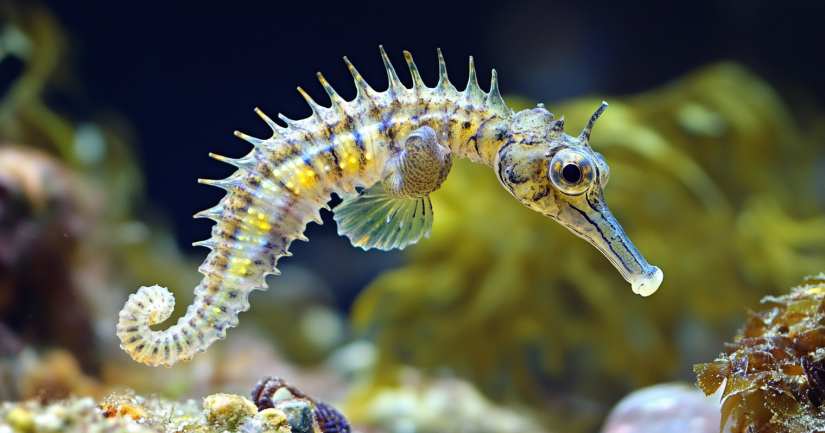
Seahorse Trivia Test Your Knowledge of These Enchanting Ocean Creatures! With their delicate, curled tails, horse-like heads, and mesmerizing way of swimming upright, seahorses are among the most unique and fascinating creatures in the ocean. These tiny marine marvels are unlike any other fish, featuring prehensile tails, armored bodies, and a remarkable ability to change color to blend into their surroundings. But their most famous trait? Males give birth to their young! Seahorses may look fragile, but they are incredibly resilient and play a vital role in marine ecosystems. How much do you really know about these extraordinary creatures? Take our Seahorse Trivia Quiz and find out!
Seahorses belong to the Syngnathidae family, which also includes pipefish and sea dragons. Unlike most fish, they swim vertically and rely on their dorsal fin to propel themselves forward, while their tiny pectoral fins help them steer. Seahorses are found in shallow coastal waters, seagrass beds, and coral reefs, where they use their camouflage skills to avoid predators.
Male Seahorses Get Pregnant and Give Birth – In the only known case of male pregnancy in the animal kingdom, male seahorses carry fertilized eggs in a specialized pouch before giving birth to hundreds of tiny babies.
Seahorses are enchanting, but the ocean has even more mysteries! Swim over to our Sea Turtle Quiz for another graceful creature or explore the fascinating habits of seals in our Seal Quiz.
Mind-Blowing Seahorse Facts That Might Surprise You
- They Have No Stomach! – Instead of digesting food over time, seahorses must constantly eat because their bodies process food so quickly. Some species eat up to 3,000 tiny shrimp per day!
- Seahorses Mate for Life (in Some Species) – Many seahorse pairs form monogamous bonds, engaging in elaborate courtship dances that include synchronized swimming and tail-holding.
- They Are Terrible Swimmers – Despite their graceful appearance, seahorses are actually one of the slowest fish in the ocean, relying on their camouflage skills rather than speed to survive.
- They Use Their Tails to Anchor Themselves – Instead of darting around like other fish, seahorses wrap their prehensile tails around seagrass and coral to prevent themselves from being swept away by ocean currents.
- Their Eyes Move Independently – Seahorses can look in two different directions at the same time, just like chameleons, helping them spot food and predators without moving their bodies.
- They Have Bony Armor Instead of Scales – Unlike most fish, seahorses are covered in a series of bony plates rather than scales, providing them with a natural armor against predators.
- They Can Change Colors Like a Chameleon – Some seahorses can change colors to blend in with their surroundings, helping them avoid predators or attract mates.
- The Smallest Seahorse Is the Size of a Grain of Rice – The pygmy seahorse grows to just 0.6 inches (1.5 cm) long, making it one of the tiniest vertebrates in the ocean.
- Seahorses Are Endangered Due to Habitat Loss – Many species face threats from pollution, climate change, and the destruction of seagrass beds and coral reefs, as well as being collected for the pet trade and traditional medicine.
The Role of Seahorses in Marine Ecosystems
Seahorses are important indicators of ocean health, as they thrive in seagrass beds, mangroves, and coral reefs—ecosystems that support thousands of marine species. Their presence signals a healthy, balanced environment, but due to overfishing, habitat destruction, and climate change, seahorse populations are declining worldwide. Conservation efforts focus on protecting their natural habitats, reducing pollution, and enforcing sustainable fishing practices.
Are You Ready to Take the Ultimate Seahorse Trivia Quiz?
If you love marine biology, ocean conservation, or just enjoy learning about quirky sea creatures, this Seahorse Trivia Quiz is for you! Whether you’re fascinated by their unique way of reproducing, their incredible camouflage, or their role in marine ecosystems, this quiz will challenge your knowledge and reveal amazing facts about these enchanting sea creatures.
So, are you ready to test your knowledge and explore the world of seahorses? Take the Seahorse Trivia Quiz now and see if you’re a true marine life expert! 🌊🐠
Love the ocean? Test your knowledge with the Guess the Sea Animal Quiz, discover your marine match in the What Sea Animal Am I Quiz, or explore more Marine Quizzes for underwater fun!
Seahorse – FAQ
A seahorse is a unique marine fish belonging to the genus Hippocampus, characterized by its horse-like head and curled tail. These fascinating creatures inhabit shallow coastal waters, often residing in seagrass beds, coral reefs, and mangroves. They are primarily found in warmer waters around the world, including the Atlantic and Pacific Oceans.
Seahorses primarily feed on small crustaceans, such as shrimp and plankton. They lack teeth and a stomach; instead, they have a specialized feeding mechanism. By extending their elongated snouts, they can suck in prey with great precision and speed, allowing them to consume food almost continuously throughout the day.
Seahorses have a distinctive reproductive process where the male carries the fertilized eggs in a brood pouch located on his abdomen. After a gestation period that can last from 10 days to six weeks, the male gives birth to fully formed, miniature seahorses. This role reversal in parenting is rare among fish and highlights the unique biology of seahorses.
Seahorses face several threats, including habitat destruction, pollution, and overfishing. Their populations are further impacted by the demand for traditional medicine and the aquarium trade. Conservation efforts are essential to protect their habitats and ensure the survival of these remarkable creatures.
Individuals can help protect seahorses by supporting sustainable seafood choices, participating in beach clean-ups, and advocating for marine conservation efforts. Educating others about the importance of seahorses and their habitats can also foster a greater appreciation and inspire collective action to safeguard these enchanting marine animals.
